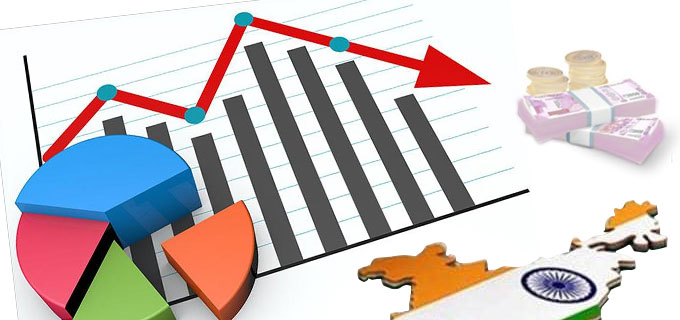
With the ever-changing market scenario and industrial conflicts, the Indian economy is currently facing its worst phase. The Indian economy is witnessing a significant decrease in various fields that are the most important factors in this slowdown phase. Many economy trailblazers have quoted economic meltdown in India. The Gross Domestic Product (GDP) has decreased from a floral rate of 8.2% in 2016-17 to 6.8% in 2018-19, with the fourth quarter of 2018-19 dipping to 5.8%. These stats are enough to tell the current situation of the Indian economy. This slowdown has deeply affected the automobile industry, sale & marketing industry, agriculture industry, etc.
Let’s understand it in a simpler way, The Gross Domestic Product (GDP) of an economy is calculated by adding private consumption expenditure, investment, government expenditure and net exports (exports minus imports). Technically, all these four inputs have drastically changed over the years but this phase is the worst. According to the State Bank of India, This economic slowdown is the consequence of global uncertainties and a substantial decline in both urban and rural wage growth. In addition to this, demonization, rollout of GST, global slowdown, collapse in private consumption, etc., are some of the main factors behind this economic slowdown. However, the quotes of various economical Pundits have turned out to be a surprising factor where they were asserting that India is the fastest-growing developing country for the last two years.
GDP in conventional terms defines the measure of all the goods and services produced inside a country. It is a movement of money through and around the economy; GDP measures the performance of the country’s economy. India’s GDP has slipped to 5.8% (fourth quarter) as compared with 8.2% in 2016-17. This has led to a significant slowdown in the Indian economy. The Indian economy is facing the most brutal time of its history and might get worse if this scenario remains the same.
( Also Read: Union Budget 2019: Nirmala Sitharaman Proposes Several Reforms For Overall Development Of The Economy)
Numerous high-frequency economic indicators help in understanding the state of each of these indicators that form the GDP. Higher GDP rate empowers firms to hire more workers and pay them higher wages that lead to more spending by consumers on goods and services. High GDP also attracts firms to invest more in the market. When GDP is low, the economy goes into recession and the opposite applies. In the current time, the Indian economy is derailed; GDP is low affecting the following industries/ sectors:
Four-wheelers and two-wheelers in terms of sale have witnessed tremendous loss as compared to the previous year. Car sale in April-June 2019 fell by 23.3 % in comparison to the same period in 2018. The two-wheeler sale is contracted by 11.7%. The sale of tractors that are high in demand across the agriculture industry fell by 14.1%, the highest fall in nearly four years. The slowdown in the automobile sector negatively affects everyone right from tyre manufacturers & suppliers to steel traders, etc. Reflection can be seen as many auto dealerships are shutting down and shrining. The vehicle loan growth has also decreased to 5.1%, slowest in the five years.
According to a known real estate research entity, in March 2019, India’s top 30 cities had 1.28 million unsold housing units showing an increase of 7% from March 2018, when the number was 1.2 million. That means, builders built the house but buyers are not investing money in real estate. The real estate sector has forward and backward linkages with other industries. So, when the real estate sector does well, cement, paint, steel, etc., do well too.
The data points go against the trend. During the second quarter of 2019, the retail loans of banks grew by 16.6% in comparison to the same period in 2018. In 2018, the growth was 17.9%. It has been a marginal fall in growth. Housing loans form more than half of the retail loans and they witnessed the growth of 18.9% during the quarter against 15.8% in 2018.
The derailed economy has also affected the FMCG sector in terms of the volume growth or the number packs sold. The volume growth of Hindustan Unilever Ltd was at 5% in the second quarter of 2019. Last year, it was 12% during the same period. Dabur India also posted volume growth of 6% during the same period against 21% last year.
There are few Indutries which shown no downfall in this slowdown are as follows:
Indian B2B marketplace has seen a massive shift. A study conducted by NetApp and Zinnov shows that B2B start-ups in India raised only $797 million in 2014 and with a rise of 364 %, they secured $3.7 billion in 2018. Another report says about 70 % of the recent start-ups are in the space of enterprise tech (41%), health-tech (9%), and fintech (19%) and. The rest 30% is in the areas of customer relationship management (CRM), software as a service (SaaS), expense management, alternative lending, medical internet of things and artificial intelligence-enabled predictive platforms. In terms of geographical locations, Bangalore abodes the maximum number of start-ups followed by Delhi and Mumbai.
( Also Read: Business-To-Business Marketplace: A Boon for Small Businesses)
The figure for the second quarter of 2019 stood at -$46 billion that is almost similar to net exports (-$46.6 billion) done by Indian exporters in 2018. The reason is both exports and imports were almost at similar levels. Given this, there has not been any bigger economic activity on Indian B2B exports either.
Add Comment